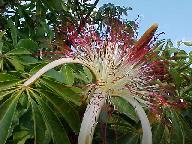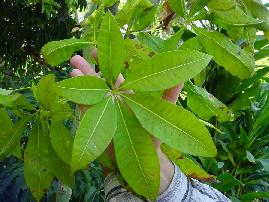 |
Charles Zidar
ANCIENT MAYA BOTANICAL RESEARCH |
|
| Family: | Bombacaceae | | Genus: | Pachira | | Species: | aquatica | | Authority: | Aubl. | | Common Name: | provision tree, provision bark | | Maya Name: | santo domingo, sapote bobo, uacut, zapote bobo, zapoton | | Depictions: | Polychrome plates and cocoa vessels | | Maya Plant Use: | Nuts used for food as well as medicine, dye and construction. Plant also used in times of famine. | | Botanical Significance: | A depiction of provision tree flowers was observed on a plate, which often held tamales. The common name “provision bark” or “provision tree” came from a tea made from the bark used when food stores were low in chicle, rubber, and mahogany camps (Arvigo and Balick 1998). The tree was used as a food source during times of drought or crop failure as well as for its many medicinal uses for blood disorders, kidney pain, anemia, and low blood pressure (Arvigo and Balick 1998). | | Ritual Significance: | The use of this tree may have connections to the Maya collapse, because it may have helped sustain the Maya during the Terminal Classic period when agricultural lands were depleted and Southern Lowland cities were falling into disuse. Flower petals on the ceramic image curl back to reveal numerous stamens that are similar to the flower. | | Photos: | Click on an image below for high resolution comparison. |
| |





